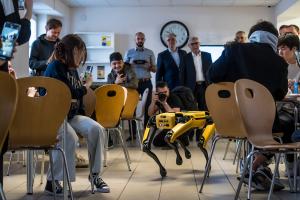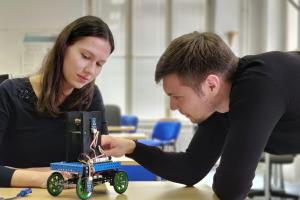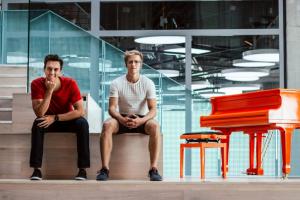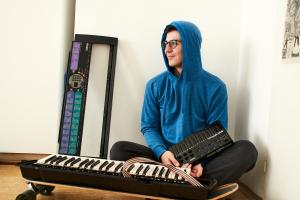Reports

2022/04/20
On April 19, the Czech Institute of Informatics, Robotics and Cybernetics of CTU in Prague organized a meeting of two worlds of art - music and painting - with the aim of supporting Ukraine. There was a concert by the CTU Academic Orchestra, which also featured harpists from Ukraine, and artist Martina Konvičková presented her painting Peace in Yellow and Blue, which was painted as a reflection to current events in Ukraine.

Improvisation and an open approach became a necessity in the 1980s in everyday life and in the practice of architecture. Some creators were able to make the best of their shortcomings and develop a distinctive, ageless handwriting. This publication by editors Petr Vorlik and Jan Zikmund from the Institute of Theory and History of Architecture at the Faculty of Architecture and their colleagues focuses on the characteristic approaches architects used to cope with the shortcomings of centrally controlled socialist building production during the era of normalisation.

The opening ceremony of the Hyundai Day took place in front of the National Technical Library on Tuesday 12 April 2022 with the participation of the Rector of the CTU in Prague doc. Vojtěch Petráček, MIAS Director Prof. Vladimíra Dvořáková and Martin Saitz, CEO of Hyundai Motor Czech Republic.

Teachers of the Department of Control Engineering of CTU FEL developed and provided students with home robotic laboratory sets. Thanks to a special teaching robot, the demanding subject of Automatic Control, including lectures, exercises and laboratories, can now be studied completely remotely. The concept of a home lab, which only a few top universities in the world are experimenting with in this field, came about during the lockdown. Currently, the department is also deploying robots in standard semester classes and is about to test their use across the entire Cybernetics and Robotics study programme.

Adam Zvada, a graduate of FIT CTU in Prague, and his partner David Mokoš founded a startup and burst onto the global crypto scene with an idea that brought them a record investment of CZK 37 million within three months.

"Change your future during your studies and start your career at leading Czech transportation companies" was the main motto of the 4th annual Career Day of the CTU Faculty of Transportation Sciences, which took place on 6 April 2022.

The sixth annual Synth Challenge 2021 competition for university students who synthesize compositions in MATLAB was won by Adrian Pitoňák, a student of FEL CTU. Among other things, he scored with the international jury with his version of Bohemian Rhapsody, which was compulsory for all participants in this year's competition.

Scientists from the Faculty of Information Technology have been awarded a prestigious Advanced ERC grant worth 77 million crowns for research into making programming language updates more efficient and cheaper. Programming languages allow programmers to interact with computers and specify tasks to be performed.

2022/04/05
An online conference organized by Climate and Sustainable Leaders Czech Republic took place in the meeting room of the Czech Technical University in Prague on Tuesday afternoon, 5 April 5.

2022/04/05
The Institute of Chemical Technology in Prague in cooperation with the Czech Technical University in Prague and the organizations Adra and Zásilkovna are dispatching a truck with humanitarian aid to Ukraine. The recipient is the Admiral Makarov National University of Shipbuilding in Mykolaiv, whose rector, Eugeny Trushliakov, has asked the universities' leadership for help. The cargo of the humanitarian transport consists of non-perishable foodstuffs, baby diapers, medical and hygienic supplies worth 1 200 000 CZK.